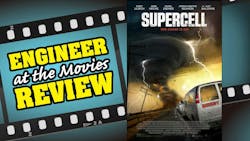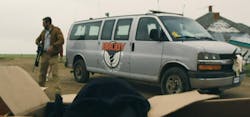Engineer at the Movies: Review of “Supercell”
What you’ll learn:
- Details on the storyline of the movie Supercell.
- The technology and gear used in the movie.
- My thoughts on Supercell.
For those unfamiliar, storm chasing is the pursuit of severe weather phenomena for curiosity, adventure, or scientific investigation to gain extensive data for use in climatology and other research. Those who follow that severe weather are known as “storm chasers,” with tornadoes being the largest objective in the field.
To that end, there have been myriad films centered around tornadoes, and contrary to popular belief, The Wizard of Oz is not the first film on the subject, as the tornado acts as a catalyst to an entirely different adventure. Rather, 1996’s blockbuster Twister was the first feature film about the subject, complete with storm chasers as the protagonists, much like the film being reviewed here—Supercell.
Supercell tells the story of William Brody (played by Daniel Diemer), the son of legendary storm chasers Bill and Quinn Brody (Richard Gunn and Anne Heche), who gains an interest in storm chasing as a child when his father teaches him about the phenomena.
After William is born, Quinn decides to become a stay-at-home mom but still monitors the storms while Bill goes on the chase. During one particularly heinous outing, Bill agrees to take a pair of college students, against Quinn’s advice, who are interested in severe weather science but are tragically killed in the process.
The Story Behind "Supercell" and the Real-World Tech
The film is based on real storm chasers, and director Herbert James Winterstern does a fantastic job presenting the story. The engaging narrative on the life of chasers combines with an incredible cinematic display of natural storms and supercells, along with convincing backdrops for the intimate scenes.
The technology presented in the film tracks with those used in the real world, providing authentic-looking props, complete with simulated functionality. One exotic device in the film, the crux of the story, is real, too! They do a great job at drawing the viewer in without being overly complicated, allowing viewers who don’t necessarily know the ins and outs of storm chasing to become engaged with the action and actors.
The actors tell the story without being overly scientific, and the chemistry between them seems natural and not forced. They work well together, and this is shown in the film. I have to admit, I was skeptical going in, but I was pleasantly surprised. Skeet Ulrich is a natural at being a mentor/father figure, while Anne Heche delivers on the role of being a widow and a concerned mother. Alec Baldwin has no issue playing the role of a greedy businessman with a hint of morality, and Jordan Kristine Seamon plays a love interest.
The special effects were well done—there was no need for flying cows here or even decimated towns or victims of collateral damage. The intimate scenes, the natural panoramas, and real storms draw the viewer in without the need for over-the-top CGI. I rate this movie 4.15/5.15.
Spoiler Alert
Shortly after the opening scene, we find the now teenage William living in Florida with his mother Quinn, who is now a house cleaner, having to raise her son as a widowed single mother. William, against his mother’s wishes, is still interested in storm chasing, and learning how to drive through his friend Harper (Jordan Kristine Seamon), who he’s been friends with for a few years and the love interest.
One day, during a thunderstorm at school, William climbs to the top of the building and uses an instrument designed by his late father and mother that can reportedly locate tornadoes using a specific frequency (more on this later), and he’s subsequently expelled from school. A bit later, he receives his father's old chase log book in the mail from his former partner Roy Cameron (Skeet Ulrich) and proceeds to hitchhike to the mailing address in Oklahoma.
Shortly after arriving, William finds out Roy is an employee of “Brody Storm Chase Tours,” a storm-chasing company owned by Zane Rogers (Alec Baldwin), who capitalized on his father’s legendary name as a cash cow to provide tours for thrill seekers.
Roy, who is like an uncle to William, is adamant about sending him back home, but begrudgingly decides to take William with him on a venture, along with Zane and a group of tourists. As they near a supercell, they pull off the road into a muddy area where they witness the formation of a tornado. At the same time, another part of the storm forms overhead, and the group takes shelter back in the van as large hail begins to fall, destroying the windows.
The Storm-Chasing Vehicles
This is perhaps one of the few details that doesn’t manage to capture its real-world counterpart, but it’s just nitpicking. The “Brody Storm Tours” van (Fig. 1), for example, provides limited to no protection against severe thunderstorms, much less tornadoes. This means it’s a stock vehicle, not designed for tornado intercepts like those featured on the Discovery channel’s Storm Chasers series. They were never meant to get close to the actual storms, but rather view them from a safe distance away.
Professional storm chasers will typically drive some type of reinforced vehicle while chasing in an effort to keep the occupants somewhat safe. Then there’s the famous Tornado Intercept Vehicle 1 (TIV 1) and Tornado Intercept Vehicle 2 (TIV 2), designed by IMAX filmmaker and storm-chaser Sean Casey.
The professional vehicles were specially designed, using armor and other safety features, to get near to, or inside of, tornadoes. The TIV 1, for example, features bullet-resistant polycarbonate windows measuring 40 mm thick to protect against flying debris. It also packs a 7.3-liter Ford Power Stroke turbodiesel that has enough power to navigate harsh terrain and keep up with tornadoes.
This is in contrast to the film’s tour vans and utility trucks, although the truck looked like it was at least intended for tough jobs. To the credit of the film, the vehicles were outfitted with what looked like hardened laptops using a local Doppler app, which also tracks in the real world.
The Tornado-Detecting Device
Later on in the film, Roy takes William to a warehouse where the teenager shows him the tornado frequency instrument (Fig. 2), which surprises Roy as he knows Bill wanted to build the device but never completed it. William also shows him the key frequency (5.15 Hz) that locates tornadoes, which his mother managed to work out by conducting a series of frequency tests.
In the movie, that frequency corresponds with the “birth” (tornadogenesis) of a tornado. In reality, the frequency is based on infrasound to detect markers in supercells that are indicative of tornadoes.
Director Winterstern worked closely with Brian Elbing, professor of Mechanical & Aerospace Engineering at Oklahoma State University (OSU), to bring a level of realism to the movie. Elbing’s work deals with infrasound, which are sound frequencies below human hearing but indicative of tornadoes born from supercells. Instead of the line-of-sight (LOS) measurements made by Doppler radar for detecting tornado rotation, infrasound measures the acoustic noise produced by tornadoes, which has been shown to carry information about them during tornado formation.
Elbing detailed this phenomenon in a 2019 paper titled “Measurement and characterization of infrasound from a tornado producing storm,” where frequency plays a significant role in the formation and life of a tornado. That frequency typically ranges between 0.5 and 10 Hz, with 5.15 Hz landing in the middle band, making it a potential marker indicating tornadogenesis as it differentiates tornadoes from other atmospheric phenomena.
Final Thoughts on "Supercell"
Supercell is an enjoyable movie from start to finish, and it doesn’t rely heavily on CGI to engage the viewer’s attention. The cinematic scenery is incredible, and director Winterstern managed to incorporate actual weather footage and onsite locations seamlessly into the film without taking away from production shots.
The essence of storm chasing is prevalent throughout the movie, making the viewers feel like they’re part of the crew along the way. The science is sound, and the addition of actual frequency infrasound to detect tornadogenesis further played into the overall realism of the film.
Check out the "Supercell" trailer:
About the Author
Cabe Atwell
Technology Editor, Electronic Design
Cabe is a Technology Editor for Electronic Design.
Engineer, Machinist, Maker, Writer. A graduate Electrical Engineer actively plying his expertise in the industry and at his company, Gunhead. When not designing/building, he creates a steady torrent of projects and content in the media world. Many of his projects and articles are online at element14 & SolidSmack, industry-focused work at EETimes & EDN, and offbeat articles at Make Magazine. Currently, you can find him hosting webinars and contributing to Electronic Design and Machine Design.
Cabe is an electrical engineer, design consultant and author with 25 years’ experience. His most recent book is “Essential 555 IC: Design, Configure, and Create Clever Circuits”
Cabe writes the Engineering on Friday blog on Electronic Design.



